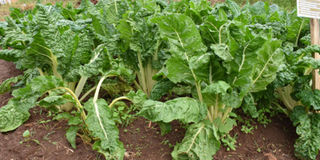Pak choi and other vegetables you can grow this rainy season

Vegetables can offer several advantages. Although many people grow vegetables as a hobby, it has proved to be a main source of food.
Home-grown vegetable gardens are not profitable for most farmers with a bulk of people looking at vegetables as a poor man’s source.
As the second rainy season approaches, experts offer a guide to vegetables you can plant now for a quick harvest.
Deborah Nakalembe is a mixed farmer in Kirangira Village, Mukono District who grows various vegetables. Nakalembe advises that farmers can plant anything they desire but her preference is cut-and-come-again vegetables such as amaranth, coriander, leaf celery, lettuce, and spinach. Her latest discovery is pak choi which she says is a good earner.
Pak choi
Twice this year, Nakalembe has grown pak choi in her gardens. She says the veg, a type of “Chinese cabbage”, is in high demand at Nakasero market for the increasing Chinese consumers. Revered as an excellent source of vitamin C, vitamin A, and manganese, and a good source of zinc, pak choi also known as bok choy provides antioxidants.
It is ideal as a salad if young leaves are harvested, but it is best when briefly cooked by stir frying.
It is ready to harvest in 30 days from sowing. Seeds germinate in 7 to 10 days. It is a perfect vegetable for cut-and-come again harvesting at intervals of two weeks. The plants thrive in warm regions but soils need to be well-worked, well-drained and rich in organic matter.
Pak choi must be watered as often as necessary to keep the soil uniformly moist. Farmers can add compost to plants. Pak choi is big on small land as approximately eight inches are left between the plants. A kilogramme, which is about five to six plants, is sold at Shs2,000 at farm gate price. Seeds are available from most shops in Container Village in Kampala.
Lettuce
Lettuce, mostly grown as a leaf vegetable, is adored for its succulent leaves, in addition to its oil-rich seeds. Nutritionally, it has all of the benefits of most green, leafy foods - antioxidants as well as trace minerals and fibre.
The vegetable requires 65-70 days to mature from seed and it is heat tolerant.
Joseph Asiimwe, the executive director of Farm Solution Africa, an agricultural consultancy on vegetable seeds, herbs, agrochemicals and market development says the vegetable adapts to many environments as it can be grown in pots or sown directly into the garden or raised beds.
The farmer is required to water regularly and keep an eye on the rabbits as well as snails. Currently, big lettuce costs between Shs1,500 and Shs2,500 and a small one costs between Shs500 and Shs2,000 on retail.
Radish
Similar to carrots in appearance, radish is rare on the list of top favourite vegetables, but it is definitely near the top when the vegetables are listed according to the benefits derived from them. It can be eaten raw as a salad vegetable as well as cooked when mixed with other vegetables.
They germinate quickly and grow fast with smaller varieties being ready for consumption within a month. A kilogramme of radish ranges between Shs3,000 and Shs5,000 depending on the season.
Spinach
Spinach is a desirable leafy green known for excellent taste and nutritional value; a reputation that stands firm to this day. It has always been regarded as a plant with remarkable abilities to restore energy, increase vitality and improve the quality of the blood.
Seeds are planted directly into the garden half an inch deep and five inches apart. In principle, the plant thrives in warm climates with soils having good organic matter. It should constantly be watered. It can be harvested in 40-52 days. A cluster of spinach can cost Shs5,000.




